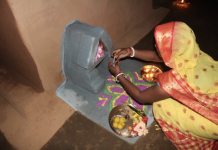In this article, a painting made by a school-going boy of 9th standard who resides in Thrissur, Kerala is analyzed through the lens of gender and in the process an attempt is made to identify the possible key concepts in gender which are prevalent in the piece.
The setting of the painting seems to be a village in rural Thrissur, Kerala. The women in the painting can be seen engaged and carrying out a range of domestic chores. She(a common collective for all the woman figurines depicted in this painting) is not only cooking or cleaning the house but is taking care of the children, domestic animals, fetching water from the well, buying groceries, milking the cow etc. The boy apparently made the painting after been tired of hearing that his mother doesn’t work and through the painting he depicted the various chores performed by his mother. The painting was shared by Shashi Tharoor through his Twitter account and currently, it is the cover page for the Kerala’s 2020/2021 gender document.
It was the beauty and simplicity of the painting that caught my attention and I found it quite interesting. The surprising component is that this painting was a Whatsapp forward message! It is surprising, at least for me, because it was the first time that I came across a WhatsApp forward message in family groups which was not only authentic but thought-provoking at the same time. The message (painting) helped me see, reflect, and identify some key concepts of gender which includes the confinement of women into private sphere and the prescribed gender roles within the same, how patriarchy works in this sphere, the power dynamics and the ways in which they all work together to ensure that oppression on women continues within the social institutions such as family and detailed analysis of the same is discussed in the following section.
Confinement within the private sphere: Unpaid Domestic Labour
In the painting, the woman is mostly performing all the household chores (unpaid domestic labour) and responsibilities which are largely located within the private sphere. The latter has some defined traits such as nurturing relationships, compassion, supportiveness, empathy, intuitive, and caring nature which are associated with women thus, making them “natural” caregivers. This sense of natural caregivers restricts women into gendered roles which are prescribed by the society at large and through these roles the sense of identity of women is formed; which is in terms of mother, wives and as homemakers.
This identity further establishes that the work women undertake in the private sphere or at home is part of her duty. Thus, the household work or chores is her responsibility. Also, women are mostly under care and protection in the private sphere of a male figure which can be a father, husband, brother etc.
In other words, they are dependent on men majorly in material sense (control over resources). “Women’s work at home, whether for the family or at a task that fetches her money, is not considered work at all. It is instead seen as an extension of her duties as a wife and a mother. By definition, the household space cannot be a site for productive activity” (Geetha & Manjrekar, 2020, p. 33).
To add further, although, in the painting, the women could be seen engaged in work such as drawing water from the well (for which she might have walked a distance) and milking the cow which is strenuous and physically demanding (words that we normally associate with men) but as the work is not considered real, the labor of women is devalued and remains socially unrecognized. The fact that the artist (boy) drew the painting to show the work done by his mother throughout the day, after being tired of hearing that his mother doesn’t work, itself showcases the way women’s unpaid domestic labor becomes invisible in our lives.
Patriarchy and Power
Another essential element of the painting is that the woman is seen carrying out the domestic chores and activities all by herself. No male figure is apparently involved or contributing in any of these chores or activities. It seems through the painting that all the work is the woman’s responsibility as it is part of the private sphere but it is important to note that men are also actively involved in the family and home, as fathers, husbands, decision makers. However, as they are involved in productive work, which is placed within the public sphere (outside world), men’s wages alone represent a living wage, and their work is primary and necessary (Geetha & Majrekar, 2020). Therefore, their participation in household chores becomes optional. It can be argued that women also participates or engages in work outside the home but the major difference is that their income or earning is considered to be a supplementary to the family’s income and if she is working it is seen as gratuitous because her prime duty lies at home. Thus, the women’s autonomy, independence and labour are delegitimized and come under control of men (Geetha & Majrekar, 2020). Many feminists also argued that this division of private and public sphere, which restricts women majorly to the former, gives unrestricted power to men to control women. The notions that the private sphere is sacred and personal, therefore, no other agent or individual/s located outside the realm of home/private can interfere in their domestic affairs be it state, judiciary etc. further marginalizes the women and in lieu of this, the domestic work/chores of women is seen as their duties and thus, remains unpaid. These ideas and notions form the basis of a concept which the feminists refer to as ‘patriarchy’. The latter is considered to be a systematic nature of men’s power and is used by feminists to describe the power relationship between men and women. “Jagger and Rosenberg (1984) patriarchy as a set of social relations between men and women, which have a material base, and which, though hierarchical, establish or create independence and solidarity among men that enable them to dominate women” (Sultana, 2011).
The painting is simple yet it portrays the role and how patriarchy and power functions within the family. The latter can be used as one of the social institutions to reproduce and legitimize the gender stereotypes which are defined and prescribed by the patriarchal ideology. Within this ideology, the biological differences between men and women are exaggerated and they are categorized into masculine and feminine roles. This ensures development of gender stereotypes and it’s made certain that men always have the dominant or masculine roles while women have subordinate or feminine roles. This subordinate or feminine role disempowers the women in various ways-they face discrimination, violence, exploitation, they are made to feel powerless as they have no/miniscule role in decision-making and lack access to resources, even their choices and sexuality is controlled and regulated. This way the men not only become superior to women but it is also justified for them to control women and thus, control their labor as well within the household and in society. “Patriarchy is based on a system of power relations which are hierarchical and unequal, where men control women’s production, reproduction and sexuality. It imposes masculinity and femininity character stereotypes in society which strengthen iniquitous power relations between men and women….this control has developed historically and is legitimized and reproduced by institutions such as family, religion, case, education, media, law, and the state” (Geetha & Majrekar, 2020, p.12).
These norms and practices of patriarchy are reproduced through various social institutions as mentioned above and in the family; this is achieved through the process of socialization. The children since early age are processed to adopt, equip, learn and internalize these norms and practices as values, habits and attitudes which are acceptable in the society. Both boys and girls are taught what to wear, how to behave, how to talk, etc in short, they are trained in gender-appropriate behavior. In this internalizing of norms, the girls also learn about their duties as a caregiver, child-bearer etc. Thus, the dominant notion of the family, which ensures that the structure of oppression and dominance over women remains intact, naturalizes (the narrative that it is done for the well-being of the women) and women remain located or fixed in their position as inferior or the ‘Other’ in relation to men.
Here, it is important to reflect or ask, in terms of socialization of women, and whether the women in the painting were performing all the activities/chores as a result of socialization? Is she just carrying out or adhering to the lessons taught in the formative years? The answer most probably to these questions is like most women she also appears to be fulfilling her destined role as a caregiver which constitutes her entire identity. Her sense of identity is limited and restricted to the space of home and her socialization does not allow her to explore other spaces. This is one of the long-lasting impacts of socialization and the way power works within the patriarchal structure. The women do not have the knowledge to identify and realize that the existing societal structures are oppressive and discriminatory and they are been dominated on the grounds of gender. This is the third face of power wherein “it operates by controlling our perceptions of ourselves, our awareness of reality, by exercising manipulative control over our minds” (McDowell & Pringle, 1992, p. 23). Through socialization the children perceptions about themselves are controlled and formed according to the ascribed gender stereotypes. The children and even the socialization agents (women figures) are also unaware about this control because it is so deeply internalized and part of everyday realities that it appears to be natural. The knowledge is controlled because the former is a source of power. If women have the knowledge about their oppression and its root cause, the patriarchal structure might be threatened as women will then be empowered or have a choice to take actions in order to liberate themselves from the oppressive structure/s.
Feminist Perspective: Socialist Feminists
On the basis of the other key gender concepts that were identified in the painting, the feminist perspective that seems relatable is of socialist feminists. Firstly, they emphasize on the economic, social and cultural importance of women as people who gives birth, socialize children, provide care to the elderly and sick and creates a realm of home as a retreat for men from the realities of the workplace and the public arena. Socialist feminists consider this as important labor which is overlooked and focused on the unpaid labour done by women in the form of domestic chores. They recognized that it helps to sustain the dominance of men over women and strengthens the patriarchal structure. Secondly, they rejected the division between public and private sphere and mentioned that this division ensures the unequal relations between men and women throughout the society. It was also stated that there are interconnections between public and private sphere and they do not exist in isolation of each other. One of the suggestions put forward by the socialist feminists is that there is a need to overcome the public and private split in order to make certain that women are empowered and liberated. Thirdly, they argued that the myths or notions that women are naturally passive, nurturer, have maternal instincts is another source of male power and these notions are further reiterated powerfully through socializing which results in women defining their major role to being mothers, child-rearer and housekeeper. Lastly, they analyzed that the main reason for women’s inferior status to men is the material base i.e. the economic dependency of women on men and therefore, to make women independent the state should provide wages to women for the domestic labor that they do.
There are majorly three gender key concepts which could be seen in the painting and the same were discussed and argued for in the paper. One, the relation between unpaid domestic labour and private sphere, how the work carried out by woman (in the painting) in the private sphere is seen as part of her duties which comes with the role of being a mother, wife, homemaker and child-rearer, makes the work unproductive, hence, unpaid. Second, the way patriarchy reinforces its ideology through the process of socialization within the family, which is one of the social institutions used by the patriarchal structure to establish its dominance. Through socialization the dominant notions, ideas and beliefs of patriarchy are internalized within the family. And third, the socialist feminist perspective to some extent discusses and addresses the aforementioned issues that were identified in the painting. They talked about the division between private and public sphere being problematic and one of the component which help men to secure its superior position over women in the society. The socialists also stressed on the importance of recognizing the unpaid labour of women and women been entitled to wages for the same.
Shivangni has done her post graduation from Ambedkar University and has been working with civil society organisations for the last couple of years.














